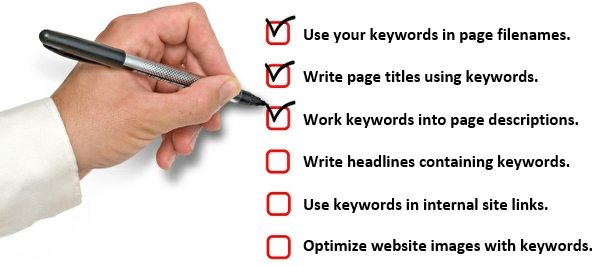Why a Checklist from a Santa Rosa SEO Company, Anyway?

They want more business, but their current website isn’t delivering it.
When I review their site, what I typically see is work done by a web designer whose focus is all on the graphics–the look and feel.
Today it is not enough to put up an attractive website. Search engine algorithms are designed to analyze keywords (not graphics), so many nicely designed web pages get NO attention from Google, Bing and Yahoo.
This results in no search traffic, no business from the website and no return on investment from all the work and budget put into it!
If the web designer had been trained or perhaps used a search engine optimization (SEO) checklist, he/she might have produced a very different work product. And, the client might not have wasted money on a site that didn’t pull search traffic!
On-

If you want your website optimized for search engines so prospective customers can find your business online, you will need to do as much on-
If you read our SEO Guide, you learned that optimization includes tactics both on and off your site. On-
You need to know this information regardless of whether you plan to hire a web designer, SEO company or want to build and manage your website yourself.
This page contains a step-
On-
On-
Many of the following tactics need to be implemented in the HTML software used to produce your website, such as Dreamweaver, WordPress, WebPlus, etc. Also, this checklist offers examples for businesses located in Santa Rosa, CA but could easily apply elsewhere by changing location names. If you are optimizing a site for national search, you will ignore references to localization.
1. Use localized keywords
(e.g. Santa Rosa, Sebastopol, Sonoma County, North Bay, etc.) if you are targeting local search traffic. For example, as a Santa Rosa SEO company, one of my main keyword phrases is used in this sentence because it improves the chances that someone looking for that service in this area will find this page when they search for it.
2. Create page filenames that incorporate your keywords.
Each
3. Write page titles that incorporate keywords.
Page titles are a highly important element of SEO, both because they can contain keywords and because it’s the first thing searchers see on the search engine results page (SERP).Using up to 60 characters, write a general title that summarizes your page content. The page title is a “meta tag,” meaning it lies beyond normal content and is only visible on the SERP.
4. Write page descriptions that incorporate keywords.
The page description is another meta tag but extremely important because it describes what searchers can expect to find in the page content. Use up to 155 characters, since search engines often truncate (cut off) descriptions longer than this.
5. Use headlines and properly code them.
Every page should have an on-
6. Make sure internal site links contain main keywords.
This is another case of search engines assigning a higher value to keywords than those in normal body text. Use keywords in your hyperlinks that direct searchers to click from one part of your site to another.
7. Optimize website images.
Although search engines don’t “see” images, they do read the filenames and ALT tags associated with those images. The image filename is similar to the page filename in that it can contain keywords. You can also use the ALT meta tag, which can be configured in most website editing software, to describe what the image is about and incorporate keywords there, too.
8. Create an XML site map.
The XML site map is used by search engines to get an overview your site, its links and when content has been changed. Having one improves site indexation and crawl rate, which can improve your SEO results. This is an option in most web design platforms (available for WordPress as a plugin), and you should use it if you can. There is also a way to manually build one, although this is pretty technical for most users.
9. Use an SEO plugin to improve your optimization skills.
Some platforms, such as WordPress enable you to add an SEO plugin to help with your optimization work. Yoast, my favorite, is user-friendly and walks you through the steps of how to optimize your pages. As you perform the steps it outlines, you are rewarded by lights turning from red to orange to green. A green lights means your page is well optimized for search engines.
10. Refresh your site and add content periodically.
Adding content, particularly keyword-
Got questions about SEO? Contact us
On-Site SEO Checklist
Follow these 10 tactics to improve your local website SEO. See the bottom section of this page for more detail.
- Use relevant keywords, localized if needed
- Incorporate keywords in page URLs
- Include keywords in page meta title
- Include keywords in page description meta tag
- Use headlines and subheads (properly coded)
- Optimize internal site links
- Optimize image metas (title tags and ALT tags)
- Create an XML site map
- Make use of an SEO plugin (e.g. Yoast)
- Refresh site content periodically
